Serving 2,527 students in grades 9-12, Judson High School ranks in the bottom 50% of all schools in Texas for overall test scores (math proficiency is bottom 50%, and reading proficiency is bottom 50%).
The percentage of students achieving proficiency in math is 19% (which is lower than the Texas state average of 41%). The percentage of students achieving proficiency in reading/language arts is 33% (which is lower than the Texas state average of 51%).
The student:teacher ratio of 15:1 is higher than the Texas state level of 14:1.
Minority enrollment is 89% of the student body (majority Hispanic), which is higher than the Texas state average of 75% (majority Hispanic).
Quick Stats (2025)
- Grades: 9-12
- Enrollment: 2,527 students
- Student:Teacher Ratio: 15:1
- Minority Enrollment: 89%
- Graduation Rate: 84% (Btm 50% in TX)
- Overall Testing Rank: Bottom 50%
- Math Proficiency: 19% (Btm 50%)
- Reading Proficiency: 33% (Btm 50%)
- Science Proficiency: 41% (Top 50%)
- Source: National Center for Education Statistics (NCES), TX Dept. of Education
School Overview
Judson High School's student population of 2,527 students has declined by 6% over five school years.
The teacher population of 170 teachers has declined by 9% over five school years.
Grades Offered
Grades 9-12
Total Students
2,527 students
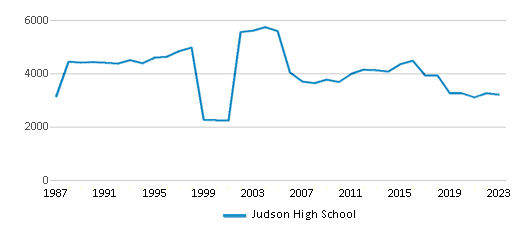
Gender %
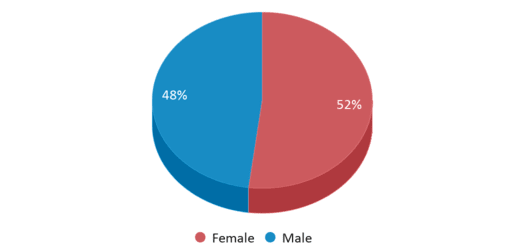
Total Classroom Teachers
170 teachers
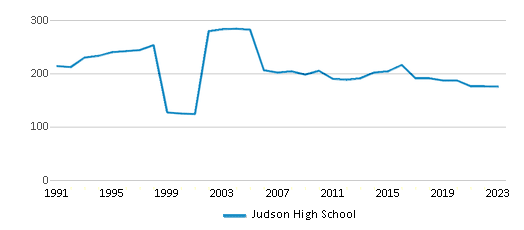
Students by Grade

School Rankings
Judson High School ranks within the bottom 50% of all 8,188 schools in Texas (based off of combined math and reading proficiency testing data).
The diversity score of Judson High School is 0.60, which is less than the diversity score at state average of 0.64. The school's diversity has stayed relatively flat over five school years.
Overall Testing Rank
#7408 out of 8188 schools
(Bottom 50%)
(Bottom 50%)
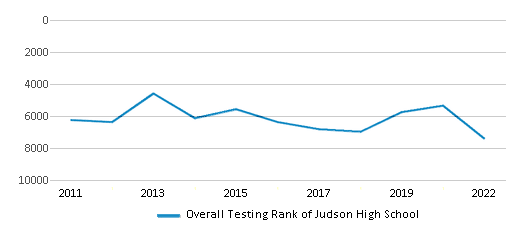
Math Test Scores (% Proficient)
19%
41%
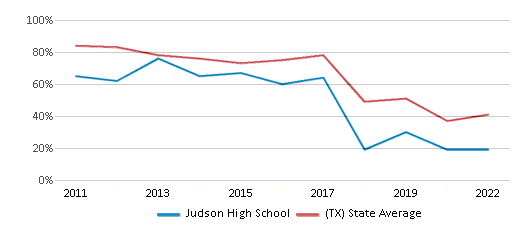
Reading/Language Arts Test Scores (% Proficient)
33%
51%
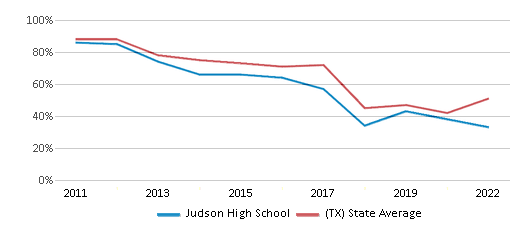
Science Test Scores (% Proficient)
41%
46%
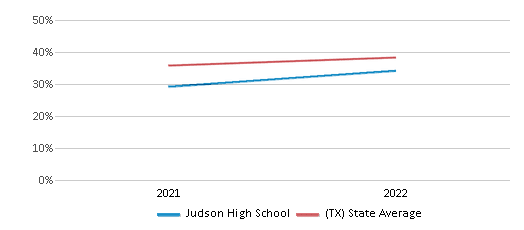
Student : Teacher Ratio
15:1
14:1
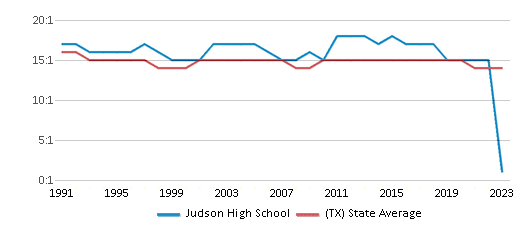
American Indian
n/a
n/a
Asian
1%
6%
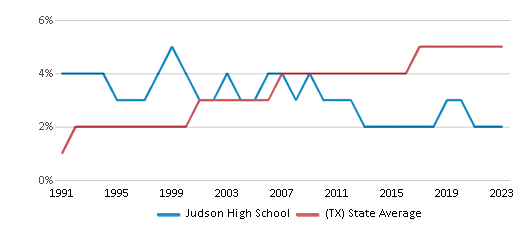
Hispanic
57%
53%

Black
26%
13%
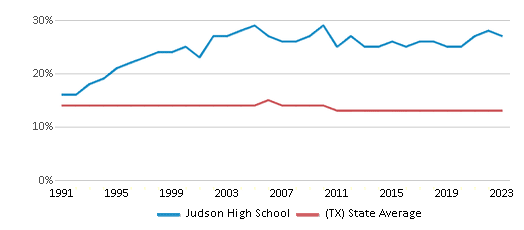
White
11%
25%
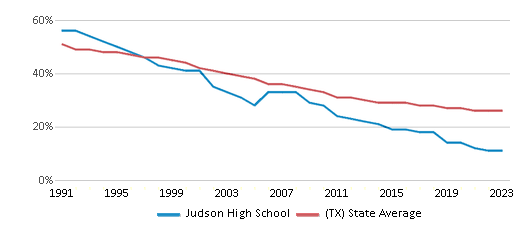
Hawaiian
1%
n/a
Two or more races
4%
3%
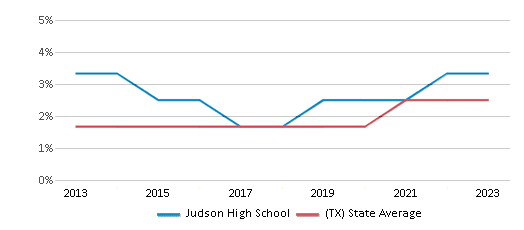
All Ethnic Groups

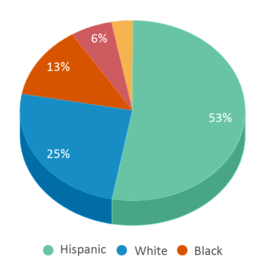
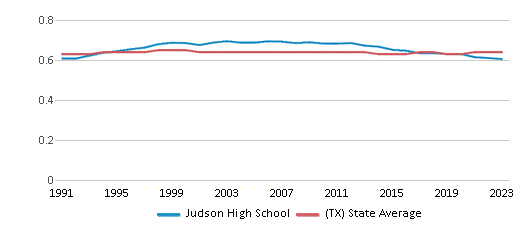
Graduation Rate
84%
90%

Participates in the National School Lunch Program (NSLP)
Yes
Eligible for Free Lunch
59%
57%

Eligible for Reduced Lunch
9%
5%
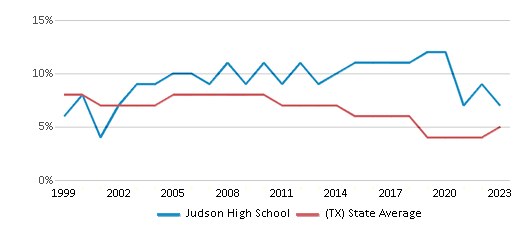
School Statewide Testing
School District Name
Source: National Center for Education Statistics (NCES), TX Dept. of Education
Profile last updated: 02/09/2025
Frequently Asked Questions
What is Judson High School's ranking?
Judson High School is ranked #7408 out of 8,188 schools, which ranks it among the bottom 50% of public schools in Texas.
What percent of students have achieved state testing proficiency in math and reading?
19% of students have achieved math proficiency (compared to the 41% TX state average), while 33% of students have achieved reading proficiency (compared to the 51% TX state average).
What is the graduation rate of Judson High School?
The graduation rate of Judson High School is 84%, which is lower than the Texas state average of 90%.
How many students attend Judson High School?
2,527 students attend Judson High School.
What is the racial composition of the student body?
57% of Judson High School students are Hispanic, 26% of students are Black, 11% of students are White, 4% of students are Two or more races, 1% of students are Asian, and 1% of students are Hawaiian.
What is the student:teacher ratio of Judson High School?
Judson High School has a student ration of 15:1, which is higher than the Texas state average of 14:1.
What grades does Judson High School offer ?
Judson High School offers enrollment in grades 9-12
What school district is Judson High School part of?
Judson High School is part of Judson Independent School District.
In what neighborhood is Judson High School located?
Judson High School is located in the Northeast Side neighborhood of Converse, TX. There are 9 other public schools located in Northeast Side.
School Reviews
2 3/14/2011
I have been so disappointed on so many levels with this school and the Converse area in general. My son did not have an english teacher for three weeks. Can you imagine what he missed in that time frame? None of the children have books. They use a smart board and the teachers print pages from the books so the kids can cram it in their backpacks. When I was at the school the other day it looked as if half of the student population were carrying trash cans on their backs. They are children for crying out loud!!! I just cannot stress enough how disappointed I am in Judson. The school is already full to capitacy and it was just rebuilt this year. Also they are discontinuing the AVID program, which helps the student prepare for college academically, find scholorships, and choose a college, etc. that they would like to go to but because the funds aren't available this course will be discontinued. Of all classes to cut this program should not be one of them. And last but not least, the teachers are overworked and underpaid for the service that they give to our children. Unfortunately, I do not see things getting any better at Judson.
Review Judson High School. Reviews should be a few sentences in length. Please include any comments on:
- Quality of academic programs, teachers, and facilities
- Availability of music, art, sports and other extracurricular activities
Recent Articles

What Is A Charter School?
Explore the world of charter schools in this comprehensive guide. Learn about their history, how they operate, and the pros and cons of this educational innovation. Discover key facts about charter schools, including admission policies, demographics, and funding, as well as what to look for when considering a charter school for your child.

10 Reasons Why High School Sports Benefit Students
Discover the 10 compelling reasons why high school sports are beneficial for students. This comprehensive article explores how athletics enhance academic performance, foster personal growth, and develop crucial life skills. From improved fitness and time management to leadership development and community representation, learn why participating in high school sports can be a game-changer for students' overall success and well-being.

February 05, 2025
Understanding the U.S. Department of Education: Structure, Impact, and EvolutionWe explore how the Department of Education shapes American education, from its cabinet-level leadership to its impact on millions of students, written for general audiences seeking clarity on this vital institution.









